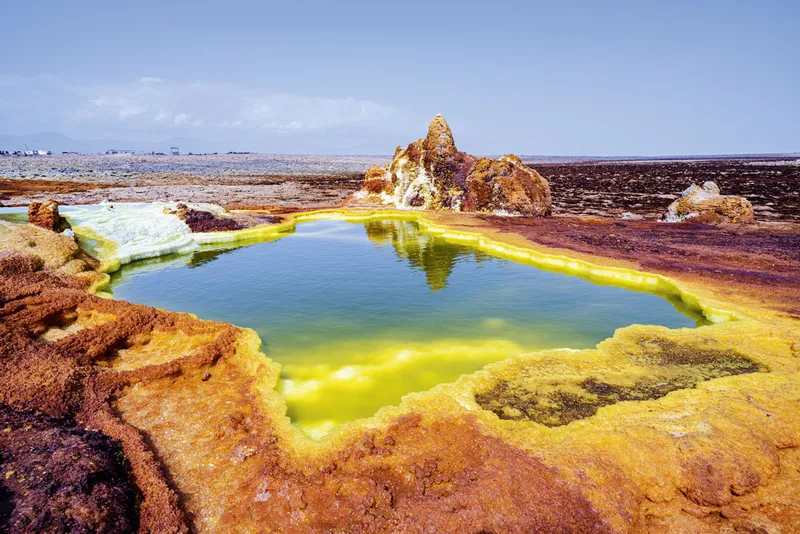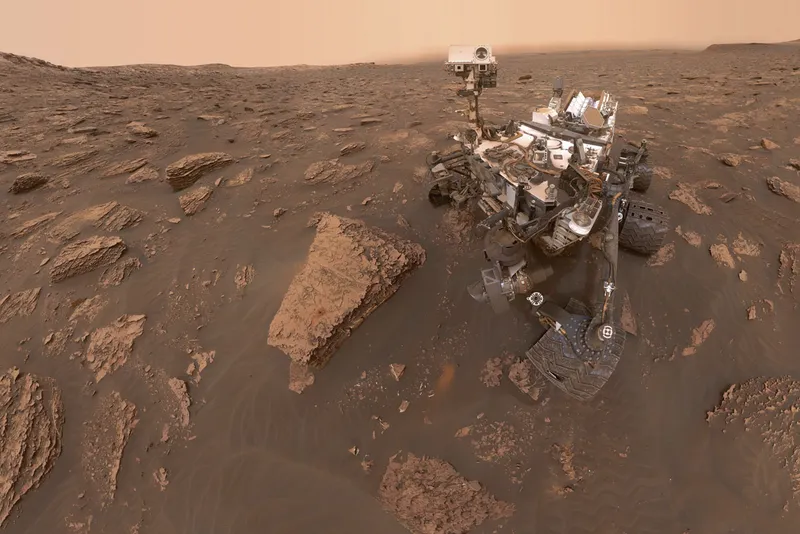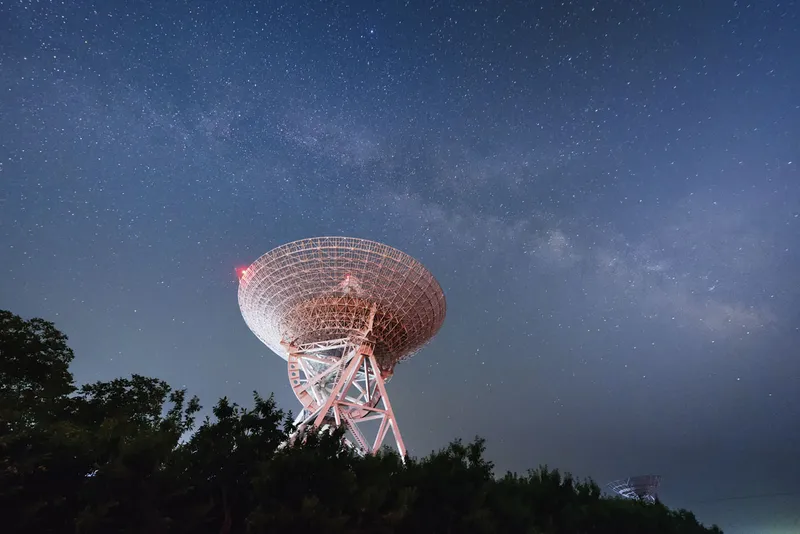
- DIGITAL MAGAZINE

MOST POPULAR
Alien investigation primary resource
Explore some of the most well-known alien mysteries.
This primary resource introduces children to the idea of extraterrestrial life. Discover some of the most well-known alien mysteries. What happened at Area 51? Why is Roswell famous as the site of an alien encounter? What do experts say about these mysteries?
Pupils will learn about how to use and review case studies, and critique evidence in our National Geographic Kids’ Alien investigation primary resource sheet.
The teaching resource can be used in study group tasks centred around investigating and evaluating evidence. It can be used as a printed handout for each pupil to review and annotate, or for display on the interactive whiteboard for class discussion.
Activity: Read the alien investigation case studies. Ask children to identify and highlight key pieces of evidence. In groups, or as a whole class, pupils could discuss the four case studies, and take a vote on what they think, using the boxes provided. As a class, read the additional information from the Search for Extraterrestrial Intelligence institute and discuss whether this changes any of their votes. Pupils could make a table with one column labelled ‘facts’ and the other ‘opinions’, and sort the key information they’ve highlighted into these two categories. Extend more able pupils by asking them to carry out further research into the case studies.
N.B. The following information for mapping the resource documents to the school curriculum is specifically tailored to the English National Curriculum and Scottish Curriculum for Excellence . We are currently working to bring specifically tailored curriculum resource links for our other territories; including South Africa , Australia and New Zealand . If you have any queries about our upcoming curriculum resource links, please email: [email protected]
This ‘Investigating evidence’ primary resource assists with teaching the following Spoken language English objectives from the National Curriculum :
Pupils should be taught to:
- listen and respond appropriately to adults and their peers
- ask relevant questions to extend their understanding and knowledge
- articulate and justify answers, arguments and opinions
- give well-structured descriptions, explanations and narratives for different purposes, including for expressing feelings
- maintain attention and participate actively in collaborative conversations, staying on topic and initiating and responding to comments
- use spoken language to develop understanding through speculating, hypothesising, imagining and exploring ideas
- participate in discussions, presentations, performances, role play, improvisations and debates
- consider and evaluate different viewpoints, attending to and building on the contributions of others
National Curriculum Upper Key Stage 2 English objectives:
Pupils should be taught about:
- distinguish between statements of fact and opinion
- retrieve, record and present information from non-fiction
- explain and discuss their understanding of what they have read, including through formal presentations and debates, maintaining a focus on the topic and using notes where necessary
This Investigating evidenc e primary resource assists with teaching the following Social studies Early level objectives from the Scottish Curriculum for Excellence :
- I am aware that different types of evidence can help me to find out about the past.
Scottish Curriculum for Excellence Social studies First level objectives :
- I understand that evidence varies in the extent to which it can be trusted and can use this in learning about the past.
Scottish Curriculum for Excellence Social studies Second level objectives :
- I can use primary and secondary sources selectively to research events in the past.
Scottish Curriculum for Excellence Social studies Third level objectives :
- I can use my knowledge of a historical period to interpret the evidence and present an informed view.
- I can evaluate conflicting sources of evidence to sustain a line of argument.
Download primary resource
Leave a comment.
Your comment will be checked and approved shortly.
WELL DONE, YOUR COMMENT HAS BEEN ADDED!
Customize your avatar.

Quiz Whiz: The Moon

Country Fact File: Tanzania!

Nat Geo Kids’ Christmas Gift Guide!

What it takes to train a penguin-protecting sheepdog – like Oddball!

Sign up to our newsletter
Get uplifting news, exclusive offers, inspiring stories and activities to help you and your family explore and learn delivered straight to your inbox.
You will receive our UK newsletter. Change region
WHERE DO YOU LIVE?
COUNTRY * Australia Ireland New Zealand United Kingdom Other
By entering your email address you agree to our Terms of Use and Privacy Policy and will receive emails from us about news, offers, activities and partner offers.
You're all signed up! Back to subscription site
Type whatever you want to search
More Results

You’re leaving natgeokids.com to visit another website!
Ask a parent or guardian to check it out first and remember to stay safe online.

You're leaving our kids' pages to visit a page for grown-ups!
Be sure to check if your parent or guardian is okay with this first.
Incorporate STEM journalism in your classroom
- Exercise type: Activity
- Topic: Astronomy
- Category: Data Analysis
The hunt for other worlds
- Download Student Worksheet
- Download Answer Key
Purpose: This activity, designed for in-class or virtual learning, encourages students to research properties and detection methods of planets outside our solar system and to use fictitious data to graph and calculate the length and depth of transit, the planet’s radius and its distance from its host star.
Procedural overview: After reading “ This is the first picture of a sunlike star with multiple exoplanets ,” students will research exoplanets, what they are and how they are discovered. Then students will divide into groups or work individually in class to plot a light curve of a transiting exoplanet from fictitious data, to gather information about the exoplanet and its movement in its solar system. A version of this article also appears in the August 29, 2020 issue of Science News , with the headline “A weird solar system cousin makes it photographic debut.”
Approximate class time: One hour
Computer with internet access
Virtual space for remote discussions and data sharing
Graph paper and pencils (optional)
The Hunt for Other Worlds student guide
Detecting Exoplanets answer key for teachers
Directions for teachers:
In this activity, students will learn about exoplanets, how they have been discovered and what scientists have learned about them. Students will use fictitious data to plot a light curve of a transiting exoplanet and then use their plots to gather information about the exoplanet and its movement in its solar system.
Want to make it a virtual lesson? Discussions can be conducted via Zoom, Skype or other suitable chat programs, while data can be shared via e-mail or through Google Docs, Sheets or Slides. In the interest of time, students should do their research on exoplanets and answer the related questions as homework before completing their worksheets in class.
For a possible extension, students could use the data, their light curves and their calculations to help create models of the exoplanet. Students could explain which properties of the exoplanet and exoplanet-star system they cannot model using the information provided, what other information they would need to find those properties and how to find that information (such as using a different method to observe the exoplanet). If time allows, students could present their models to the class.
By the autumn of 2020, there were about 4,300 confirmed extrasolar planets, or “exoplanets,” discovered in around 3,200 planetary systems around other stars. More than 5,400 additional candidate exoplanets have been proposed by NASA programs alone. Many other groups around the world are also searching for and proposing candidate exoplanets.
Most of the known exoplanets are large gas giants, ranging from about the size of Neptune to several times the size of Jupiter. Scientists have found a smaller number of “super-Earths,” which are planets that are thought to be larger than Earth and to have a combination of terrestrial and gaseous conditions. A handful of smaller, rocky planets also have been discovered that are similar in size to Earth or smaller. As of September 2020, no extraterrestrial life has been found on an exoplanet.
About 98.8 percent of confirmed exoplanets have been discovered using four methods. The transit method looks for a slight dip in the amount of light coming from the star, which indicates that a body is crossing between the star and Earth. The radial velocity method looks for a wobble in the star’s motion directly toward and away from Earth, which indicates another celestial object is tugging on the star. Microlensing looks for a change in the light coming from a distant star when it is behind a nearer star, which bends light like a lens and makes the distant star appear brighter. If the lens star has an exoplanet, the distant star appears even brighter, a hint that an exoplanet is present. Planets can also be directly imaged, but this can be very difficult because the amount of light reflected by the planet is typically very small compared with the star it is orbiting. Direct imaging can be performed after the star’s light has been blocked or by thermal imaging.
A few other methods that have led to exoplanet discoveries include astrometry, transit-timing variations, eclipse-timing variations and pulsar timing.
More detailed information can be found in resources such as:
NASA Exoplanet Exploration , including 5 Ways to Find a Planet
What are exoplanets? from EarthSky
How to Search for Exoplanets , from The Planetary Society
Homework reading and questions for students
Before class, students will read about exoplanets and discovery methods using the following or similar resources:
Your Guide to Exoplanets , from The Planetary Society
The questions below will help the students complete their research on exoplanets and understand what they are seeing in the data and their graph.
Note that the student sample answers provided will be based on information current as of September 2020; the number of known exoplanets is growing quickly, and common methods of detection may change with technological advancements. Please use current data and information when grading student answers.
1. What is an exoplanet?
An exoplanet is a planet that is in orbit around another star outside our solar system.
2. What was the first exoplanet to be discovered? When and how was it discovered?
The first confirmed exoplanet discovery was in 1992 and consisted of two terrestrial planets orbiting pulsar PSR B1257+12. They were discovered by timing the pulses of radiation emitted by the pulsar. The 2019 Nobel Prize in physics was awarded for the 1995 “discovery of an exoplanet orbiting a solar-type star. ” T he name of that exoplanet is 51 Pegasi b.
3. Describe the four main methods of exoplanet detection.
Radial velocity: The wavelengths of light from the star change as the star moves slightly toward us (blueshift) and slightly away from us (redshift).
Transit: The amount of light visible from a star drops slightly as the planet crosses in front and blocks some of the light that reaches Earth.
Direct imaging: Host stars are much brighter than the exoplanets that go around them. To directly image an orbiting exoplanet, astronomers use techniques to block the star’s light so the planet can be seen. Exoplanets have been imaged directly in the visible light part of the electromagnetic spectrum and in the infrared part of the electromagnetic spectrum.
Microlensing: Changes in the light from a far distant star behind an exoplanet’s host star can indicate the presence of an exoplanet.
4. To date, approximately how many exoplanets have been discovered? You may notice different numbers such as “confirmed” or “candidates.” What is the difference between them?
Answers should reflect current values — values will change with time as more exoplanets are discovered. As of September 2020, there were about 4,300 confirmed exoplanets and about 5,400 candidate exoplanets. Confirmed exoplanets mean that the data have been verified and do show an exoplanet. The data of candidate exoplanets show an anomaly that may indicate an exoplanet, but it has not yet been verified.
5. About how many have been discovered by each detection method?
Answers should reflect current values — values will change with time as more exoplanets are discovered. In September 2020, about 3,200 of the confirmed exoplanets had been discovered using the transit method. About 800 exoplanets were discovered using the radial velocity method. About 50 exoplanets were discovered using direct imaging. About 100 exoplanets were discovered using microlensing. The rest were discovered by other methods, including astrometry, transit-timing variations and eclipse-timing variations.
6. What is the approximate range in mass of confirmed exoplanets?
Answers should reflect current values — values will change with time as more exoplanets are discovered. As of September 2020, exoplanets range from 0.02 times Earth’s mass to more than 8 times Jupiter’s mass.
7. What are the nearest and farthest discovered exoplanets? What method(s) were used in their discovery?
Answers should reflect current values — answers may change with time as more exoplanets are discovered. As of September 2020, the nearest known exoplanet is Proxima Centauri b, which was discovered with the radial velocity method and is about 4 light-years away. The farthest known exoplanet is SWEEPS-4b, which was discovered with the transit method and is about 27,700 light-years away.
8. What is the habitable zone around a star? Is it the same for each star?
It is the range of orbits around a star where liquid water could exist on the surface of a planet, and the planet could potentially have conditions suitable for life. Each star has a different habitable zone based on its temperature.
9. Have any exoplanets been found in the habitable zone of their host stars?
Yes, exoplanets have been discovered that are within their stars’ habitable zones .
10. During class you will act like an astronomer who has gathered data while studying a potential exoplanet. You will use this data to create a graph showing how the amount of light measured changes over time. Which value will go on the x-axis and which will go on the y-axis? How do you know?
Time goes on the x-axis because it is the independent variable: It is consistent and unchanged by experimentation. The amount of light goes on the y-axis because it is the dependent variable: It will change over time depending on circumstances.
Group discussion about exoplanets
Use the following questions to lead your students as a class or in small groups through a brief discussion on what they learned in their pre-class readings. Again, note that the student sample answers provided will be based on information current as of September 2020. The number of known exoplanets is growing quickly, and common methods of detection may change over time, so be sure to use current data and information when grading student answers.
1. Which of these detection methods has been the most successful for discovering exoplanets? Why do you think that is?
The transit method has found most known exoplanets. This is probably the most successful method because a survey can watch the same patch of sky for long periods of time and is able to catch the slight changes in brightness when the exoplanet transits its star.
2. In addition to studying the target stars that might host an exoplanet, astronomers also use several nearby stars to gather comparison data. Why do they do this?
Astronomers observe the brightness of several stars near the target star to correct for any potential fluctuations in the data, such as from atmospheric disturbances or changes in sky brightness.
3. Most of the exoplanets discovered early on were very large, including some that are several times the mass and radius of Jupiter. Why do you think the larger exoplanets were discovered first?
The larger exoplanets were easier to spot because they caused greater disturbances visible from Earth. They could have blocked more of the light from their host stars as they transited, or they caused their host stars to have larger wobbles than smaller planets, due to greater gravitational pulls.
Detecting exoplanets
Ask students alone or in small groups to pretend to be astronomers who have collected and processed the fictitious data found on their Hunt for Other Worlds student guide , which they will use to create a light curve of a transiting exoplanet orbiting the star GSC 00522-01199 in the Delphinus constellation. Students will then analyze their light curves and use the provided data to answer the questions in the Detecting Exoplanets worksheet, found in their student guide. For worksheet questions and answers for teachers, please refer to the Detecting Exoplanets answer key .
Possible extension
A possible extension to this activity would be to have students create a model of the exoplanet’s star system. They should use the data, their light curves and their calculations to create their models. They should also explain which properties of the exoplanet and exoplanet star system they cannot model using the information provided. Students should include other information they will need to find those additional properties (such as using a different method to observe the exoplanet). If time allows, students can present their models to the class.
- Ask An Astrobiologist
- Resources Graphic Histories Coloring Pages Heroes Posters Life in the extremes Digital Backgrounds SciComm Guild

Exoplanets/Exoplanets Worksheet
Comparing the earth to an exoplanet.
Subject Integrated: Science
Rationale: In this lesson, students will compare Earth to one of the many exoplanets found by the Kepler spacecraft.
Objectives: Students will be able to compare Earth’s characteristics to those of a specific exoplanet.
- Worksheet (Appendix 2)
- https://www.nasa.gov/kepler/discoveries
- The class could have a costume party, dressing up as exoplanet residents and banqueting on brainstormed exoplanet foods.
- One Google Slide per planet, per student or small group.
- What can we compare and contrast between Earth and your selected exoplanet?
- Optional : Rubrics can be made to score the completion of the requirements on the Google Slide as summative assessment.
- Google slide can be posted on class webpage for study purposes.
- Optional: Rubrics can be used for evaluation of oral presentation.
- NGSS : MS-ESS2-2. (supportive fit) Construct an explanation based on evidence for how geoscience processes have changed Earth’s surface at varying time and spatial scales.
Click here to download the pdf of this lesson. Click here to download the pdf of the Exoplanet Worksheet
Return to: Life Out of This World: Lesson Plans
The content was developed at Albion College by Professor Nicolle Zellner (Albion College Department of Physics) and Victoria Della Pia (Albion Elementary School), with educational oversight by Melissa Mercer-Tachick (Muse Consulting). To develop these lesson plans and assessments, Victoria Della Pia was supported by a grant from the Foundation for Undergraduate Research, Scholarship, and Creative Activity at Albion College.

Log in Create an Account
E.T. The Extra-Terrestrial: Film Guide

Short (1-4 activities)
Related calendar events
World Space Week 4 October - 10 October
This resource is part of the following theme
A film guide that looks at E.T. The Extra-Terrestrial (1982), a heartwarming family favourite about an alien stranded on Earth who attempts to find his way home.
This guide is useful for exploring topics including English and Science in addition to highlighting themes surrounding aliens, friendships, growing up, space and planets, scientists and inventors, child safety, and community.
This resource includes

E.T. The Extra-Terrestrial Film Guide
A short PowerPoint of activities focusing on E.T. The Extra-Terrestrial.
Size: 37.19 MB
Login or Create an Account
This Resource Supports
Got some feedback.
We love to hear how educators have used our resources.
Updating our resources
We have developed a large catalogue of educational resources since launching in 2013, and some references and terminology will inevitably have dated as society and language evolves. We are aware of this and will be updating resources when our production schedule allows.
Related Films

E.T. The Extra-Terrestrial (1982)
Stream on Into Film+
6,107 reviews
This heart-warming family favourite about an alien stranded all alone on earth contains some of the most magical scenes in movie history.

Age group 7–14 years
Duration 115 mins

How do Into Film Clubs work?
Find out more about what's involved in running your very own Into Film Club.
Find out more

Learn how to make the most of film in education with our training programme.

The Iron Giant (1999)
5,113 reviews
Superbly animated adaptation following young Hogarth's discovery of a colossal, friendly robot, and his plight to protect him from government agents.
Age group 5–14 years
Duration 86 mins

Lilo & Stitch (2002)
Stream on Into Film+ Premium
270 reviews
Animation about a weird little being who escapes from the prison of his evil creator and goes to planet Earth, where he pretends to be a dog.
Age group 5–11 years
Duration 82 mins
Viewing 2 of 2 related items.
What our educators say
"The Filmmaking Guides have been invaluable in helping novice filmmakers, from ensuring their story is well told, to thinking about light, camera angles and editing." - Simon Pile, Deputy Headteacher, Anson Primary School, London

- Share on Facebook
- Tweet This Resource
- Pin This Resource

The Search for Extraterrestrial Life
In this extraterrestrial life worksheet, learners review the different space craft used to explore space for existence of life beyond Earth. This worksheet has 8 matching and 5 unscramble words.

Start Your Free Trial
Save time and discover engaging curriculum for your classroom. Reviewed and rated by trusted, credentialed teachers.
- Collection Types
- Activities & Projects
- Assessments
- Graphics & Images
- Handouts & References
- Interactives
- Lab Resources
- Learning Games
- Lesson Plans
- Presentations
- Primary Sources
- Printables & Templates
- Professional Documents
- Study Guides
- Instructional Videos
- Performance Tasks
- Graphic Organizers
- Writing Prompts
- Constructed Response Items
- AP Test Preps
- Lesson Planet Articles
- Online Courses
- Interactive Whiteboards
- Home Letters
- Unknown Types
- Stock Footages
- All Resource Types
See similar resources:
C. elegans and the search for extraterrestrial life, everything, the universe...and life, what studying earth can tell us about life on mars, should we be looking for life elsewhere in the universe, why can't we see evidence of alien life, is anyone out there examining astrobiology and the value of seti, science kids: space videos: nasa kepler mission, nasa: nasa's carl sagan fellows to study extraterrestrial worlds, the search for other earth-like planets, science kids: space videos: the search for life.
- Subscribe to BBC Science Focus Magazine
- Previous Issues
- Future tech
- Everyday science
- Planet Earth
- Newsletters
The 4 biggest questions about alien life, answered by an astrobiologist
Scientists are becoming increasingly optimistic that extraterrestrial life is out there. Could we finally be on the brink of finding it?
Photo credit: Getty
Prof Lewis Dartnell
There’s never been a more exciting time than right now in the search for life beyond Earth. This fast-paced field is called astrobiology and it’s one of the more interdisciplinary branches of science, combining biology, chemistry, planetary science and astronomy.
Most life in the Milky Way is expected to be single-celled microbial lifeforms, like Earth’s bacteria, but perhaps some worlds support more complex forms of life, such as plants and animals.
Recent advances in three main areas have boosted astrobiologists’ optimism that we could be on the brink of discovering the first signs of extraterrestrial life: extremophiles, exoplanets and robotic exploration.
What three things are making astrobiologists so optimistic about finding life beyond Earth?
1. extremophiles.
The more we learn about micro-organisms on Earth, the more we’re surprised by the incredible adaptability of life.
The hardiest lifeforms are known as extremophiles and they’ve been discovered surviving in some very inhospitable environments.
They’ve been found in boiling-hot hydrothermal vents, beneath freezing-cold glaciers, in acidic pools of volcanic water, deep under Earth’s crust, and even in high-radiation zones.
Extremophiles teach astrobiologists about the outer limits for life and what sort of extraterrestrial environments might be habitable.

2. Exoplanets
Before 1992, the only planets we knew existed in the entire galaxy were the ones in our Solar System. Since then, our telescopes have discovered almost 5,400 worlds orbiting other stars – so-called extrasolar planets, or exoplanets.
Most of the first exoplanets detected were bloated gas giants orbiting exceedingly closely to their suns – not the sort of world we believe could harbour life. But these were just the easiest to detect; we’ve since discovered smaller and smaller exoplanets orbiting further from their stars.
For astrobiology, the most exciting exoplanets are small, rocky, Earth-like ones orbiting the right distance from their stars so that their surface temperatures allow oceans of liquid water.
These are potentially habitable worlds and would offer the best chances for extraterrestrial life. Future space-based telescopes would hopefully be able to detect signs of life – called biosignatures – in their atmosphere, such as the presence of oxygen gas released by photosynthesis.
- What are the odds that aliens are humanoid?
- Is searching for aliens worth the risk? Absolutely, says UK’s leading astronomer
3. Robotic exploration of the Solar System
Over recent decades, advances in robotics and the sophistication of scientific instruments have made our space probes more and more capable.
There has been a fleet of orbiter, lander and rover missions launched to Mars, as well as probes sent to explore the outer planets, Jupiter and Saturn, and their families of moons.

Every time we visit another world we learn an enormous amount about its environment, active processes and its history – and invariably spark a whole slew of new questions to answer.
These space probes (as well as telescopes like Hubble) have revealed that a handful of planets and moons in the Solar System have potentially habitable environments that could support extraterrestrial life.
Could aliens be silicon-based?
All life on Earth needs liquid water to survive – it’s very good at dissolving chemicals to support the reactions of biochemistry. Life here is also organic (built from complex molecules based on carbon atoms).
It makes most sense for astrobiology to search for the sort of life we know is possible and we have a good idea how to detect. But could extraterrestrial life be based on a completely different kind of chemistry?
The element silicon sits just below carbon on the periodic table and so, in many ways, its chemistry is similar. But compared to carbon, silicon isn’t nearly as good at forming stable chemical bonds and large, complex molecules. Alien life could be based on solvents other than liquid water, however: perhaps ammonia.
Where in the Solar System could there be alien life?
Today, the surface of Venus is a hellish landscape, hotter than an oven due to the greenhouse effect of the planet’s thick carbon-dioxide atmosphere.
But early Venus may have been more like Earth and there’s a chance that any Venusian microbial life may have been able to survive by migrating high into the atmosphere.
At altitudes of 50-60km (30-40 miles) the temperature is cooler and an aerial biosphere may exist in the clouds. The clouds are highly acidic, though, so Venusian life is probably unlikely.
While the modern surface of Mars is a freeze-dried desert, blasted by ultraviolet rays from the Sun, around 3.8 billion years ago it’s thought to have been much warmer and wetter. There’s evidence of ancient lakes, river valleys and possibly even a large ocean covering the northern hemisphere.
Organic molecules – the building blocks of life – are also thought to have been present on the Martian surface and so maybe the Red Planet developed life of its own. Any Martian microbes are probably long since extinct on the surface but may survive deeper underground.
Europa is one of the large moons orbiting Jupiter. Although its surface is hard-frozen ice, there’s a deep ocean of liquid water beneath it, kept warm by ‘tidal heating’ from the moon flexing and distorting as it orbits in the gas giant’s powerful gravitational field.
This process may also drive hydrothermal vents on the Europan seafloor, which serve as oases for life in Earth’s oceans.
The key question for exploring Europa is, just how thick is its icy shell? And, would it be possible to get some kind of submersible probe beneath it to search for marine life?

4. Enceldaus
Enceladus is a moon of Saturn, but in many ways is like Europa. It has a cold, icy surface and an ocean of liquid water laying underneath that’s in contact with the moon’s rocky core.
Jets of water squirt out of long fractures in the icy crust around the south pole and analysis of these has revealed the water is salty. Organic molecules have also been detected in these plumes and there’s evidence for hydrothermal activity.
So even though this alien ocean is thought to be pretty alkaline, it could still be habitable for life.
Titan orbits Saturn. It’s a giant of a moon, and is the only moon in the Solar System to have a thick atmosphere that is rich with organic chemistry.
Large lakes have been discovered around Titan’s north pole, but these are filled with liquid ethane and methane, rather than water. It’s still an open question as to whether life could be ethane-based rather than water-based, but Titan is a complex world and may harbour lifeforms with a biochemistry very different to those on Earth.
Could aliens be intelligent?
Astrobiology is mostly focused on searching the Solar System for signs of hardy, single-celled life, or detecting atmospheric biosignatures in exoplanets.
But could there be more complex life in the galaxy – alien plants and animals, or even intelligent, space-faring beings?

The galaxy is very old, and intelligent life could have evolved on another habitable world many millions of years before us, and potentially spread across the whole galaxy.
But despite over 60 years of sporadic programmes listening for artificial radio transmissions or looking for signs of technological structures, we’ve not found any convincing evidence of intelligent life out there… yet.
Share this article
You may also like, science focus, doctor who: could aliens really wipe your memory, advanced aliens could soon detect life on earth, thanks to our leaking mobile towers, 15 of the best space and astronomy books 2024, biological space race: nasa doctor reveals the future of genetically edited astronauts, dr douglas vakoch: should we try to contact aliens, alien contact: a brief history of extraterrestrial languages, ‘oumuamua: why did we think it was aliens, could alien life breathe a gas other than oxygen.

- Terms & Conditions
- Privacy policy
- Cookies policy
- Code of conduct
- Magazine subscriptions
- Manage preferences
E.T., the Extra-Terrestrial
Loading ad...
TeacherMelanIre
E.T. film: choose the right answer
- Google Classroom
- Microsoft Teams
- Download PDF

Worksheet: The Quest for Extraterrestrial Life | Class 7 English Alive PDF Download
Multiple choice questions (mcqs) with explanations.
Q1: What was the main purpose of the Ohio State University Radio Observatory's Big Ear radio telescope?
(a) To monitor weather patterns on Earth.
(b) To search for extraterrestrial intelligence.
(c) To study the Earth's atmosphere.
(d) To observe terrestrial radio frequencies.
Ans: (b) To search for extraterrestrial intelligence.
Explanation: The Big Ear radio telescope was primarily utilized to search for extraterrestrial intelligence, focusing on detecting any unusual or artificially generated radio signals that might suggest the presence of intelligent life beyond Earth.
Q2: What is the significance of the 'Wow! Signal'?
(a) It confirmed the existence of extraterrestrial life.
(b) It was a repeated signal from another galaxy.
(c) It is considered the best candidate for a signal from extraterrestrial intelligence.
(d) It led to immediate contact with an alien civilization.
Ans: (c) It is considered the best candidate for a signal from extraterrestrial intelligence.
Explanation: The 'Wow! Signal' is significant because it remains one of the strongest candidates for a signal from extraterrestrial intelligence. Detected in 1977, this signal's duration and characteristics suggested it was not a typical natural or man-made interference, yet it has not been observed again.
Q3: Which project aims to cover ten times more sky area in search of alien communication?
(a) The Voyager Project
(b) The Apollo Missions
(c) The Breakthrough Listen Project
(d) The Hubble Telescope Program
Ans: (c) The Breakthrough Listen Project
Explanation: The Breakthrough Listen Project is a large-scale initiative funded to expand the search for extraterrestrial communications. It plans to scan ten times more sky area than previous efforts, significantly increasing the chances of detecting alien signals.
Q4: What does the Drake Equation estimate?
(a) The age of the universe
(b) The number of intelligent alien civilizations in our galaxy
(c) The distance to the nearest star
(d) The size of the Milky Way
Ans: (b) The number of intelligent alien civilizations in our galaxy
Explanation: The Drake Equation is used to estimate the number of civilizations in the Milky Way galaxy with which we might be able to communicate. It considers factors like the rate of star formation, the fraction of those stars with planets, and the likelihood of life developing on those planets.
Q5: What was the outcome of the signal observed by the Parkes radio telescope in 2019?
(a) It was confirmed as a signal from Proxima Centauri.
(b) It was likely noise or interference from Earth.
(c) It proved the existence of artificial broadcasts from space.
(d) It was identified as a natural radio emission.
Ans: (b) It was likely noise or interference from Earth.
Explanation: The signal observed by the Parkes radio telescope had characteristics that initially seemed unusual, but further analysis led researchers to conclude that it was likely caused by interference from Earth, rather than being an extraterrestrial communication.
Fill in the Blanks
Q1: Serious scientific efforts to search for extraterrestrial life began with the advent of __________ technology.
Q2: SETI stands for the __________.
Ans: Search for Extraterrestrial Intelligence.
Q3: The signal detected by the Big Ear telescope in 1977 is known as the __________ Signal.
Q4: Frank Drake developed an equation to estimate the potential number of intelligent alien civilizations, known as __________ Equation.
Ans: Drake's
Q5: The __________ was started in 2015 with funding of $100 million to search for alien communication.
Ans: Breakthrough Listen Project
True/False Questions
Q1: The SETI Institute was founded by Carl Sagan and Jill Tarter in 1984.
Q2: The 'Wow! Signal' was detected multiple times after its initial observation.
Q3: The Breakthrough Listen Project plans to cover only a small part of the sky.
Q4: Mars could have been habitable in the past.
Q5: All signals detected by SETI have been confirmed as extraterrestrial.
Match the Column

Ans: A-2, B-3, C-4, D-1
Explanation
A-2 : SETI focuses on searching for extraterrestrial intelligence.
B-3 : Drake Equation estimates the potential number of communicable civilizations in the galaxy.
C-4 : Mars Sample Return is about bringing Martian samples back to Earth for analysis.
D-1 : Active SETI involves broadcasting messages to space, hoping for a response from alien civilizations.
Top Courses for Class 7
Mock tests for examination, shortcuts and tricks, objective type questions, study material, video lectures, previous year questions with solutions, extra questions, worksheet: the quest for extraterrestrial life | class 7 english alive, semester notes, important questions, past year papers, sample paper, practice quizzes, viva questions.

Worksheet: The Quest for Extraterrestrial Life Free PDF Download
Importance of worksheet: the quest for extraterrestrial life, worksheet: the quest for extraterrestrial life notes, worksheet: the quest for extraterrestrial life class 7 questions, study worksheet: the quest for extraterrestrial life on the app, welcome back, create your account for free.

Forgot Password
Unattempted tests, change country, practice & revise.

Extraterrestrial Life
“If aliens ever visit us, I think the outcome would be much as when Christopher Columbus first landed in America, which didn't turn out very well for the Native Americans.” Stephen Hawking (1942 – 2018), British theoretical physicist
- December 9, 2020
- General English
- No Comments
Home » Extraterrestrial Life
Latest lesson plans

LESSON OVERVIEW
This free ESL lesson plan on space travel has been designed for adults and young adults at an intermediate (B1/B2) to advanced (C1/C2) level and should last around 45 to 60 minutes for one student.
Are we alone in the Universe? This is one of the most profound questions humans have pondered and one that we are unable to answer. Considering how many millions of planets there are that are capable of supporting life in our galaxy alone, the probability that intelligent life exists somewhere else in the Universe is high. In that case, where are these aliens? Why haven’t they visited us or even bothered to send a text to say hello? Well, according to some people, they already have but the government has kept this information secret. In this ESL lesson plan on extraterrestrial life, students will have the opportunity to discuss and express their opinions on issues such as whether or not life exists elsewhere in the Universe, what would happen if we made contact with an alien civilisation and whether this contact would be a good thing.
This lesson plan could also be used with your students to debate these issues for World UFO day , which takes place on either June 24th (the date of the first ever sighting of a UFO in 1947) or on July 2nd (the date a UFO supposedly crashed near Roswell, New Mexico, also in 1947). For more lesson plans on international days and important holidays, see the calendar of world days to plan your classes for these special occasions.
For advice on how to use this English lesson plan and other lesson plans on this site, see the guide for ESL teachers .
PRE-CLASS ACTIVITIES
Reading activity Before the English class, send the following article to the students and ask them to read it while making a list of any new vocabulary or phrases they find (explain any the students don’t understand in the class):
BBC Newsround | “What is Area 51?”
The article refers to an event that was organised on Facebook with the intention of ‘storming’ Area 51, a top-secret US Air Force base in Nevada. It gives a summary of the conspiracy theories and UFO sightings that have surrounded the base since the 1950s and also talks about the supposed UFO crash landing in Roswell, New Mexico. At the start of the class, hold a brief discussion about what the students thought about the article. What do they think happens at Area 51? Did a UFO crash land in Roswell? Why do people believe these conspiracy theories?
Video activity To save time in class for the conversation activities, the English teacher can ask the students to watch the video below and answer the listening questions in Section 3 of the lesson plan at home. There are intermediate listening questions and advanced listening questions so teachers can decide which would be more appropriate for their students. Check the answers in the class.
The video for this class is called “The Fermi Paradox — Where Are All The Aliens?” by Kurzgesagt – In a Nutshell which provides a worrying explanation as to why we have not been visited by aliens.
Courtesy of kurzgesagt.org
IN-CLASS ACTIVITIES
The focus in the class is on conversation in order to help improve students’ fluency and confidence when speaking in English as well as boosting their vocabulary.
This lesson opens with a short discussion about the article the students read before the class. Next, the students can give their opinion on the quote at the beginning of the lesson plan – what they think the quote means and if they agree with it. This is followed by an initial discussion on the topic including why we have not made contact with aliens, what the students would say to an alien given the opportunity and what TV shows or movies they have seen featuring aliens.
After this, students will learn some vocabulary connected with extraterrestrial life such as alien abduction , crop circle and humanoid . This vocabulary has been chosen to boost the students’ knowledge of less common vocabulary that could be useful for preparing for English exams like IELTS or TOEFL. The vocabulary is accompanied by a cloze activity and a speaking activity to test the students’ comprehension of these words.
If the students didn’t watch the video before the class, they can watch it after the vocabulary section and answer the listening questions. Before checking the answers, ask the students to give a brief summary of the video and what they thought about the content.
Finally, there is a more in-depth conversation about aliens. In this speaking activity, students will talk about issues such as why aliens would want to visit us, whether or not they might have already made contact with us and the possibility that life on Earth was created by a galactic civilisation.
After the class, students will write a guide to Earth for a visiting alien. This could be a short paragraph or a longer piece of writing depending on what level the student is at. The writing activity is designed to allow students to practise and improve their grammar with the feedback from their teacher. For students who intend to take an international English exam such as IELTS or TOEFL, there is an alternative essay question to practise their essay-writing skills.
DOWNLOAD LESSON PLANS

Did you find this lesson plan useful?
Your English Pal is a free resource to help fellow ESL teachers save time when preparing their classes. If these lesson plans have helped you, and you’d like to help keep the site free, please consider making a small contribution to help cover the site’s costs. Any help you can give is much appreciated!
Leave a Comment Cancel Reply
Your email address will not be published. Required fields are marked *
Save my name, email, and website in this browser for the next time I comment.
Copyright © 2023 Your English Pal
Privacy Overview

IMAGES
VIDEO
COMMENTS
Replace the lid, tape at two points and label at the edge with a marker pen. Repeat steps 1-3 for another area on the key board. Using the UV cleaning device, clean the keyboard by holding it about 2cm away from the surface for 10-20 seconds in each area. Repeat steps 1-4 for the same two areas on the keyboard.
ET Puppets: Extraterrestrial Puppets with Options 3. Exoplanets/Exoplanets Worksheet: Comparing the Earth to an Exoplanet 4. NASA Missions: Investigating NASA Space Missions 5. NASA Scientists: Interviewing a NASA Scientist, with Options 6. Scavenger Hunt / Scavenger Hunt Worksheet: Ingredients of Life Scavenger Hunt 7.
For this part of the activity, you will pretend that you are an astronomer who has collected data about an exoplanet transiting the star GSC 00522-01199 in the constellation Delphinus using a 0.8 ...
The teaching resource can be used in study group tasks centred around investigating and evaluating evidence. It can be used as a printed handout for each pupil to review and annotate, or for display on the interactive whiteboard for class discussion. Activity: Read the alien investigation case studies. Ask children to identify and highlight key ...
As of September 2020, no extraterrestrial life has been found on an exoplanet. ... For worksheet questions and answers for teachers, please refer to the Detecting Exoplanets answer key.
Students are responsible for researching what is known (or estimated) about the mass, location, host star, constellation, distance, temperature, orbit of the exoplanet. Once information is found and recorded, students are to create a class combined Google Slide for each for each of the exoplanets researched to use to learn about each one.
SETI WebQuest and the Drake Equation. For Teachers 7th - 12th. Students complete a WebQuest where they research the Internet for extraterrestrial intelligence. In this extraterrestrial lesson plan, students also explore how the Drake Equation can predict the occurrence of life elsewhere. +.
This 11 page movie guide with handouts accompanies the film "E.T The Extra-Terrestrial (1982)". ★★ Check out the full preview! ★★This guide may also work well as a sub plan for your substitute teacher.Part 1 - Consists of 6 questions all on the subject of aliens to be completed before the movie. The...
The Extra-Terrestrial (1982), a heartwarming family favourite about an alien stranded on Earth who attempts to find his way home. This guide is useful for exploring topics including English and Science in addition to highlighting themes surrounding aliens, friendships, growing up, space and planets, scientists and inventors, child safety, and ...
This The Search for Extraterrestrial Life Worksheet is suitable for 9th - 12th Grade. In this extraterrestrial life worksheet, learners review the different space craft used to explore space for existence of life beyond Earth. This worksheet has 8 matching and 5 unscramble words.
Exoplanets Science Projects. (3 results) An exoplanet or extrasolar planet is a planet outside the Solar System. The first confirmation of an exoplanet detection occurred in 1992. As of 1 October 2019, there are 4,118 confirmed exoplanets in 3,063 systems, with 669 systems having more than one planet. Figure 1.
Scientists are becoming increasingly optimistic that extraterrestrial life is out there. Here, an astrobiologist explains why.
An alien, E.T., short for Extra-Terrestrial, is left behind on earth when his spaceship has to leave suddenly. He is all alone at night on a strange planet. He is outside a family's house, and the children know 'something' is out there. One of the children, Elliott, goes out to look, but E.T. runs away.
extraterrestrial organism should obey the laws of chemi-stry and physics - at least in a scientific context - and any biological function requires complex chemistry. Carbon-based molecules are generally seen as the only way to provide the intricate building blocks for this [1]. Follow the water
Browse Extraterrestrial objects activity resources on Teachers Pay Teachers, a marketplace trusted by millions of teachers for original educational resources.
School subject: English as a Second Language (ESL) (1061958) Main content: E.T. film (1641753)
Document Description: Worksheet: The Quest for Extraterrestrial Life for Class 7 2024 is part of Class 7 English Alive preparation. The notes and questions for Worksheet: The Quest for Extraterrestrial Life have been prepared according to the Class 7 exam syllabus. Information about Worksheet: The Quest for Extraterrestrial Life covers topics like Multiple Choice Questions (MCQs) with ...
In this ESL lesson plan on extraterrestrial life, students will have the opportunity to discuss and express their opinions on issues such as whether or not life exists elsewhere in the Universe, what would happen if we made contact with an alien civilisation and whether this contact would be a good thing. This lesson plan could also be used ...
Skills Practiced. This quiz and worksheet allow students to test the following skills: Reading comprehension - ensure that you draw the most important information from the related lesson on ...
About This Quiz & Worksheet. Despite the notion of extraterrestrial life being a continuous focus of pop culture, we still haven't really come close to finding actual alien life on other planets.
Embark on a sweet adventure with our " Extraterrestrial Life " Word Search worksheet. This delightful word puzzle is designed to bring joy to young learners. Here are the words featured in this word search puzzle:
Test based on E.T.: The Extra-Terrestrial Penguin Active Reader and movie. Over a period of 11 weeks we read a chapter from the book and watched the corresponding period of the movie. Kids really enjoyed it. Test designed to take approx 25 minutes
Students definitely have to do critical thinking in this lesson as they try to explain how their beavers evolved into new species. They also have to draw their planet and newly evolved beaver as well as explain what kind of adaptations he has and how they help him survive. I also threw some research technique in their as I expected them to look ...